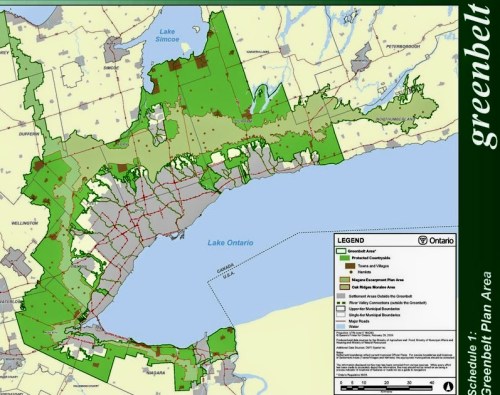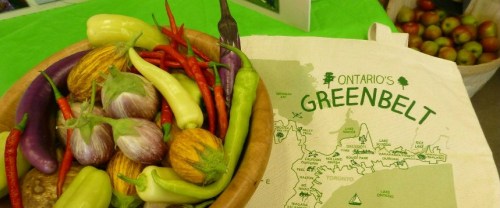Greenbelts Play Vital Role in Adapting to the Growing Threat of Climate Change
Report Examines Eight Greenbelts Around The World, Ranging From Brazil To Denmark, To Shine A Light On The Threats And Opportunities They Face
A News Release from The Greenbelt Foundation in Ontario
Posted July 27th, 2022 on Niagara At Large
 (A Brief Foreword by Doug Draper at Niagara At Large – I post the following piece less than two months after roughly 18 per cent of eligible voters in Ontario who bothered to vote elected a second majority government for Doug Ford and his Conservatives in the province for the next four years.
(A Brief Foreword by Doug Draper at Niagara At Large – I post the following piece less than two months after roughly 18 per cent of eligible voters in Ontario who bothered to vote elected a second majority government for Doug Ford and his Conservatives in the province for the next four years.
Ford has promised to build and expand multi-lane highways through the Greenbelt that will encourage more car and truck traffic and low-density sprawl. He was also caught on video in the past, promising developers that he would be willing to allow “chunks” of the Greenbelt to be paved over for housing.
So here we go. Thanks to those who voted this Ford government back in and to those who couldn’t bother to vote, we stand to lose more of our green heritage in an era of climate emergency.
-
Doug Draper, Niagara At Large)
TORONTO, Ontario — The protection and enhancement of greenbelts around the world is more important than ever to the future of the cities and regions in which they exist. That is one of the key findings of a new report that shows how greenbelts, or natural areas with protected land-use policies, are evolving globally to respond to current and emerging conditions.
Greenbelts Around the World Responding to Local and Global Challenges by the Greenbelt Foundation includes eight international case studies, and it provides an update to a similar report published in 2010. For the study, interviews were conducted with experts from around the world on four main themes: 1) nature-based solutions; 2) food and agricultural system; 3) outdoor tourism and recreation; and 4) growth management.

A map of Ontario’s Greenbelt. Let’s fight to save it from Doug Ford and the shortt-sighted greed in this province’s development industry.
Greenbelts are becoming increasingly important in the face of mounting global challenges, such as climate change, disruption in global food systems, extreme weather events, rising energy prices, and water issues and needs.”
Greenbelts are becoming increasingly important in the face of mounting global challenges, such as climate change, disruption in global food systems, extreme weather events, rising energy prices, and water issues and needs. In the past decade, policymakers, planners and the public have become more aware of the environmental and economic importance of protected natural areas.
 Some of the benefits include urban growth control, climate change mitigation and adaptation, supporting local economies, nature conservation, tourism and recreation, and protection of agricultural land. The COVID-19 pandemic has further highlighted the significance of proximity to nature for the health and well-being of residents more than ever before.
Some of the benefits include urban growth control, climate change mitigation and adaptation, supporting local economies, nature conservation, tourism and recreation, and protection of agricultural land. The COVID-19 pandemic has further highlighted the significance of proximity to nature for the health and well-being of residents more than ever before.
The research revealed many examples of innovative practices in other regions to support and enhance greenbelt policies. In British Columbia, the province created the Buy BC program to help promote regional agriculture, food and drinks. In São Paulo, a variety of agritourism and ecotourism programs are designed to showcase natural, historical, and gastronomical features of the Green Belt Biosphere Reserve.
In Frankfurt, a green mascot for the city’s greenbelt is used in educational and tourism material, including signage for hiking and cycling trails, and in the school curriculum. These popular initiatives provide unique opportunities for residents to create stronger connections to their greenbelts.
Researchers also found that threats to greenbelt protections have considerably increased on an international level since 2010. These include changing greenbelt boundaries through the encroachment of urban and suburban development into protected areas, a lack of national and regional leadership and policy oversight, creation or expansion of infrastructure projects and natural resource extraction zones, and the erosion of features and systems that the greenbelt was designed to protect due to an overuse of recreational areas and tourism.
The study found that the Ontario Greenbelt, which provides over 40 per cent of the province’s fruit and tree nuts, is a world leader for its strong legal, regulatory and policy framework. This is achieved by not undermining Greenbelt boundaries or weakening policy, and a significant investment by the province in the Greenbelt Foundation, which is a unique organization among the case studies, as a steward of the Greenbelt.
“The report confirms the Ontario Greenbelt is an international leader in land use planning and protection,” said Edward McDonnell, Greenbelt Foundation CEO. “That success is underpinned by a strong policy framework with broad public support, and its implementation is supported by dedicated civil society groups and the Foundation.
All this contributes to making the Ontario Greenbelt a vibrant and thriving landscape – for the residents and the economy. The report also highlights the constant threats that natural environments around the world face, and the need to strengthen our efforts to protect and preserve greenspaces.”
To maintain healthy greenbelts, and thus, healthy and thriving local communities, the report emphasizes the need for consistent leadership by regional and national governments, strong public awareness and support, growing local food infrastructure, and investment in ecological and agricultural opportunities within greenbelts. Specific recommendations for the Ontario Greenbelt include leveraging Greenbelt Foundation activities to advance the objectives of the Greenbelt Plan, promoting Greenbelt-grown products, and increased stakeholder coordination to manage infrastructure and resource extraction projects.
“Green Belts have become increasingly relevant for sustainable development of the landscape, as well as for the conservation of genetic resources, threatened species and ecosystem services,” said Dr. Liana Geidezis, Regional Coordinator for the Central European Green Belt, BUND.
“Safeguarding Green Belts and biodiversity is not an option but a condition for a viable, resilient future. We are currently experiencing massive destruction of natural and semi-natural habitats worldwide. Green Belts are a very effective response to the global loss of habitats, species and to climate change, so international studies and mutual exchange are of great importance.”
Greenbelts have been used to manage urban development and protect farmland and natural areas for more than 100 years. The new report shows these natural areas are one of the most effective tools to prevent further climate change and critical for a healthy supply of clean air, food and water.
To read the full report, please click here. For a backgrounder with further information, please click here.
Additional Quotes
“Greenbelts are globally significant reservoirs of natural resources essential to the future of humanity, and they also provide crucial health benefits. Yet no international policies exist for their protection and national, state and city protection mechanisms are commonly deficient. The Ontario Greenbelt provides a leading international example of protection, and the Greenbelt Foundation has played a vital role in promoting Greenbelt protection globally.” – Michael Buxton, Professor Emeritus in Environment and Planning, RMIT University, Melbourne, Australia.
“Greenbelts continue to evolve in form and function to respond to contemporary challenges, including climate change. In recent years, the concept of the Greenbelt has evolved to include more multi-functional goals, such as climate change mitigation and adaptation, economic development, promoting regional identity, and the provision of ecosystem services.” – Thomas Bowers, Director of Research and Policy at the Greenbelt Foundation.
 About Greenbelt Foundation – Greenbelt Foundation is a charitable organization, solely dedicated to ensuring the Greenbelt remains permanent, protected and prosperous. We make the right investments in its interconnected natural, agricultural, and economic systems, to ensure a working, thriving Greenbelt for all. Ontario’s Greenbelt is the world’s largest, with over two million acres of farmland, forests, wetlands and rivers working together to provide clean air, fresh water, and a reliable local food source.
About Greenbelt Foundation – Greenbelt Foundation is a charitable organization, solely dedicated to ensuring the Greenbelt remains permanent, protected and prosperous. We make the right investments in its interconnected natural, agricultural, and economic systems, to ensure a working, thriving Greenbelt for all. Ontario’s Greenbelt is the world’s largest, with over two million acres of farmland, forests, wetlands and rivers working together to provide clean air, fresh water, and a reliable local food source.
Niagara At Large is reprising this video of Doug Ford telling developers that he wants to take out “chunks” of Ontario’s Greenbelt lands for urban sprawl. To watch it, click on the screen below –
NIAGARA AT LARGE Encourages You To Join The Conversation By Sharing Your Views On This Post In The Space Following The Bernie Sanders Quote Below.

Now the climate crisis goes on, anything GREEN is important. Thank you 🌍🙏
LikeLike
Doug Ford’s black belt in politics overrides any greenbelts or environmental disasters or global warming threats. He’s a well funded expert in exploiting.
LikeLike
Where’d you get 18 percent voted in last ontario provincial election ?
The official percentage was 43 percent, albeit still disgustingly low.
https://toronto.ctvnews.ca/ontario-records-lowest-voter-turnout-in-election-history-1.5931440
LikeLike